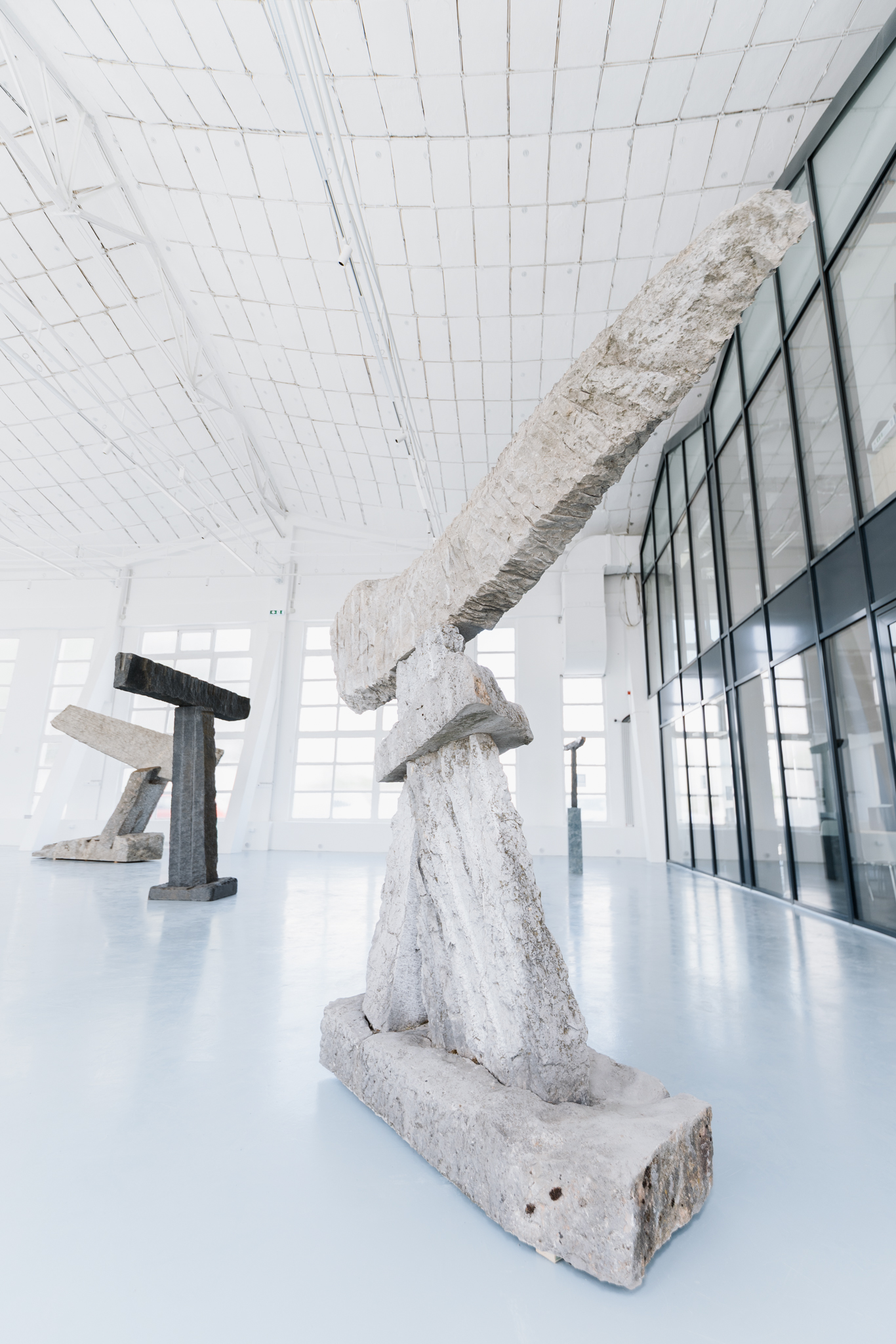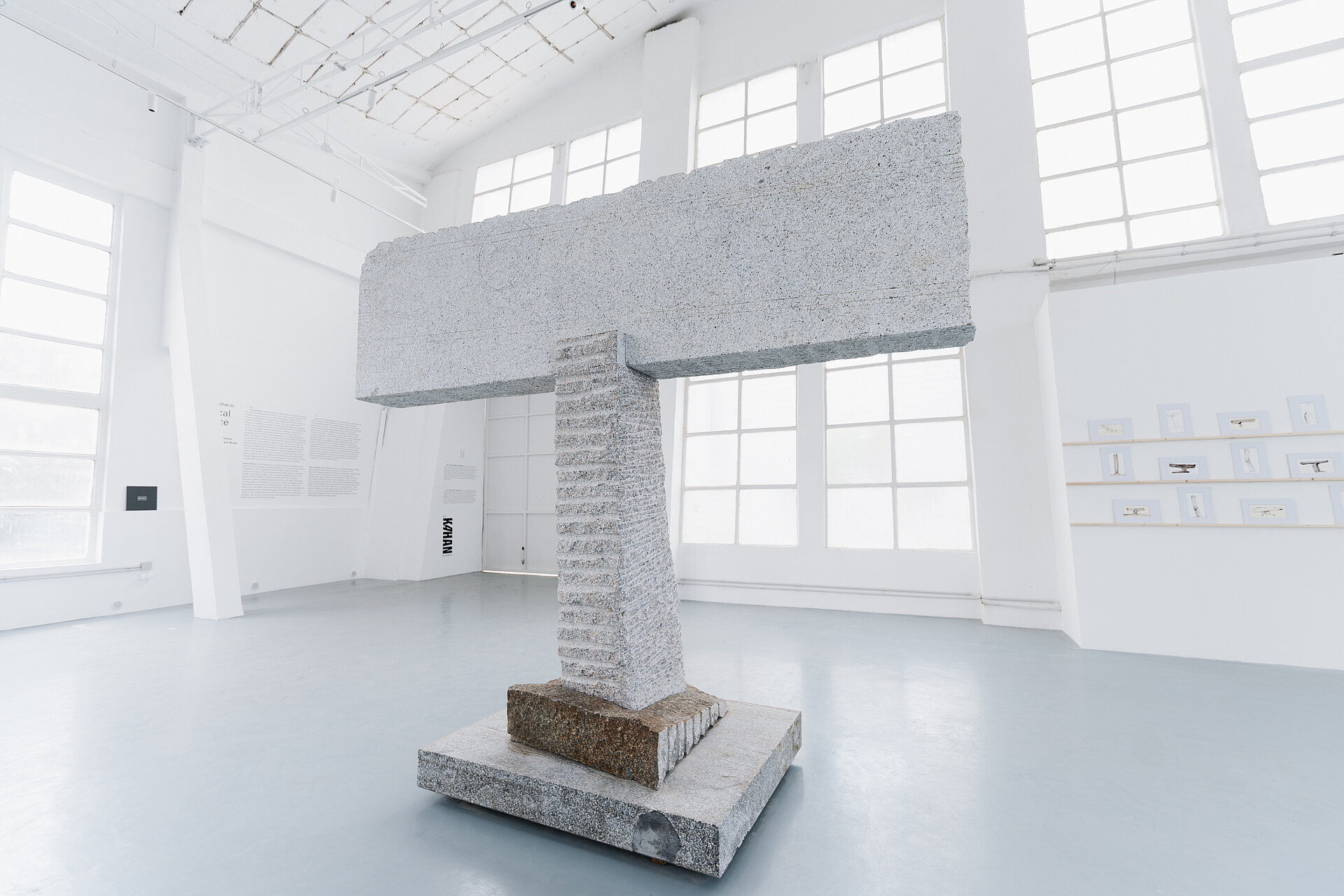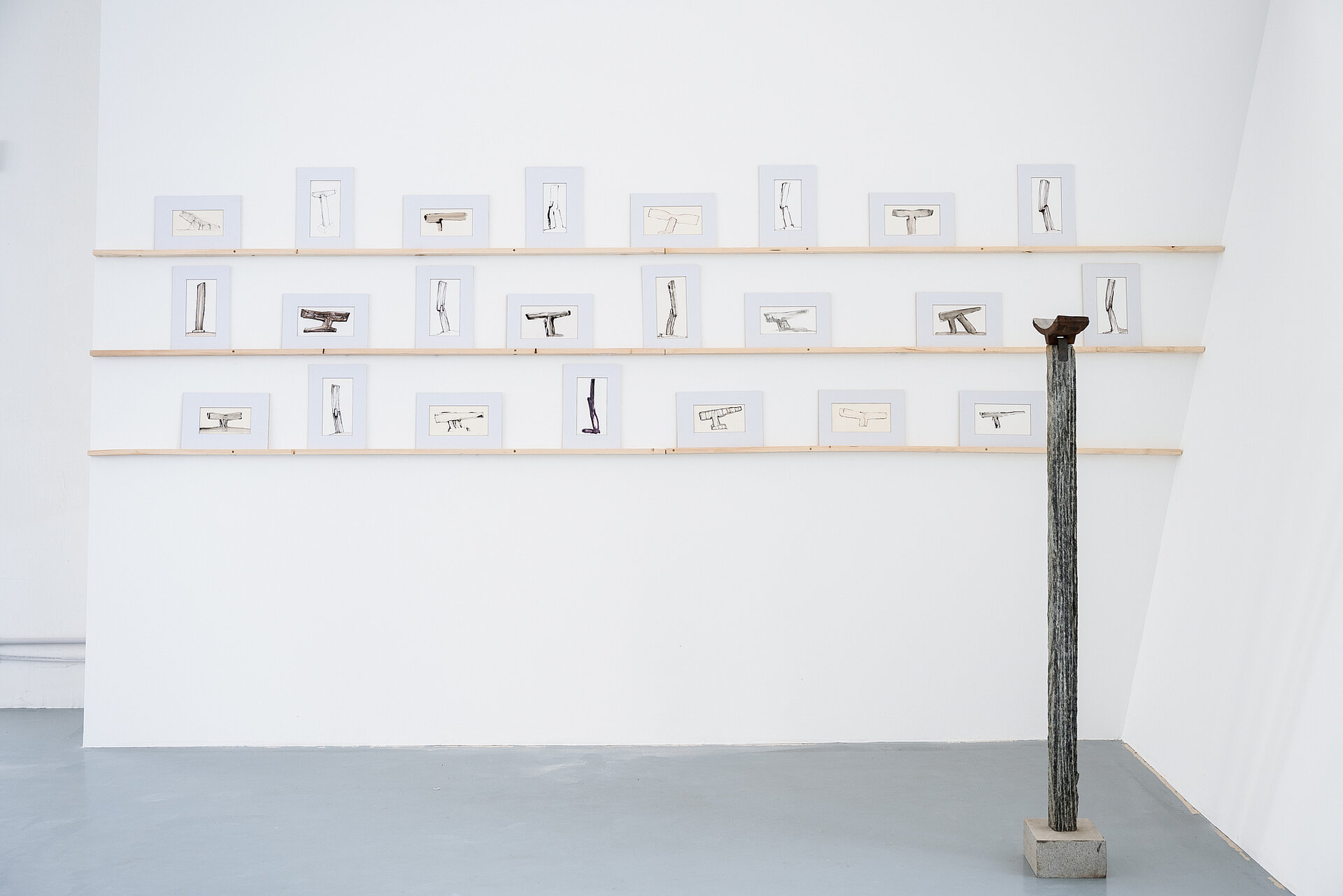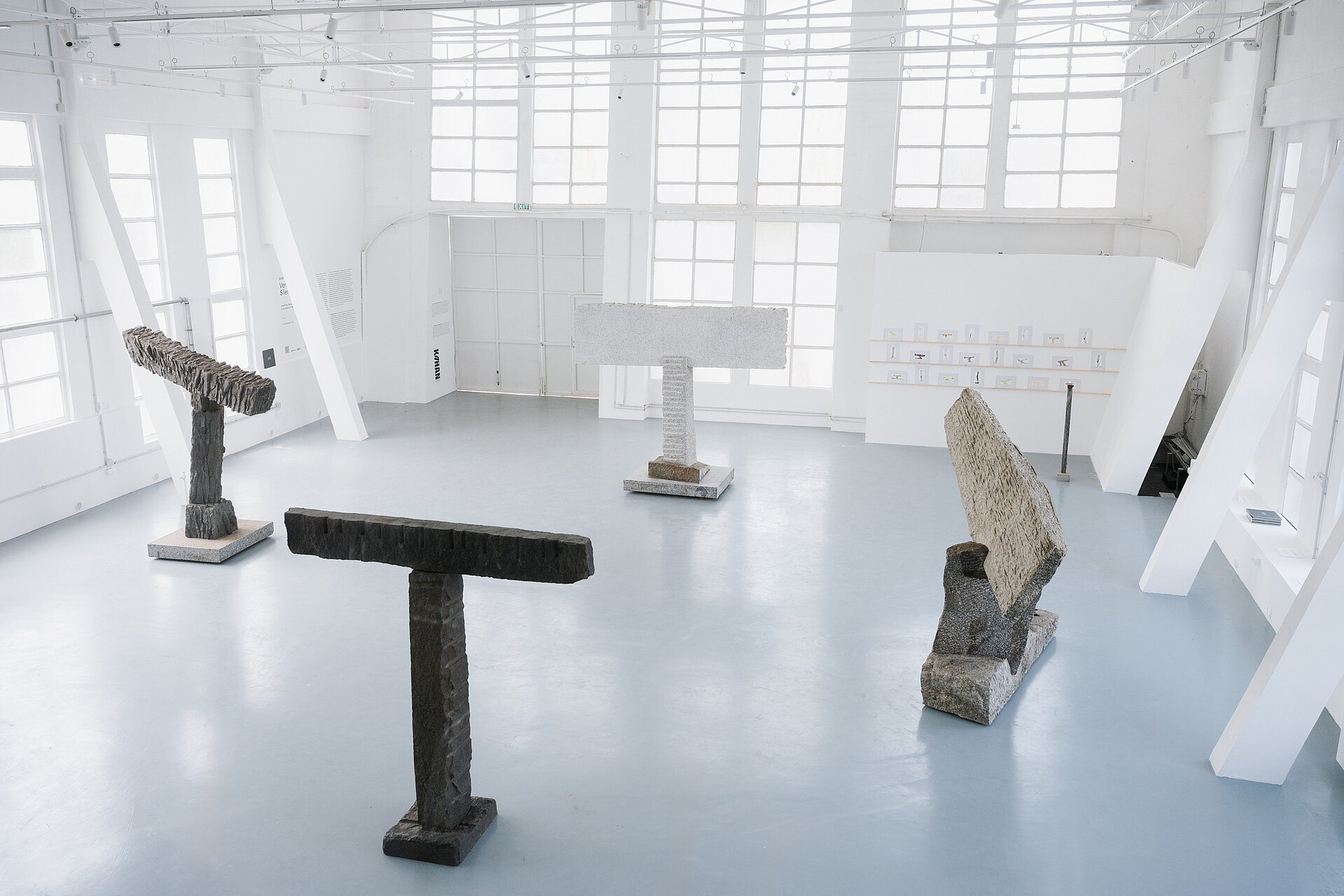VERTICAL SILENCE
Andras Mohacsi
In the dominant philosophical discourses of the 20th century – particularly within phenomenology – stone was long considered a “bare thing”: a worldless, meaningless object. Yet stone is an ancient witness and medium of the world, present in both the material and spiritual layers of culture: in our literary and visual artworks, monuments, ritual objects, and daily items. As a slowly eroding analogue carrier of messages, it also conveys a sense of permanence and order. Within it are concentrated the forces of nature, archaic forms of knowledge, and the universal symbols of art.
Vertical Silence, the solo exhibition of András Mohácsi, presents a selection from over three decades of the artist’s practice, with particular emphasis on the timeless presence of his monumental stone sculptures. Mohácsi’s artistic language and way of thinking were shaped by the tradition of the Villány Art Colony – established in 1967 and pivotal in the history of Hungarian sculpture – where, as a student of István Bencsik, he adopted the principles of autonomous, internally driven sculptural practice. The land art movement of the 1960s – with key figures such as Robert Smithson and Nancy Holt – alongside the parallel emergence of minimalist and anti-form sculpture that explored the notion of space, as seen in the works of Richard Serra, Ulrich Rückriem, and Robert Morris, had a profound influence not only on the theoretical and institutional frameworks of Western art but also – albeit indirectly – on the artistic scenes of Eastern Europe, shaped under political repression. In Hungary, these international tendencies became legible primarily through the practices of artist residencies and symposia established from the late 1960s in remote or peripheral locations – such as those in Villány and Dunaújváros. These colonies operated as autonomous zones, where the use of natural materials – stone in Villány, steel in Dunaújváros – along with shifts in scale, site-specific thinking, and the analytical exploration of landscape, space, and the human presence, gave rise to discourses that radically diverged from the official sculptural norms of the time. This non-narrative and conceptual approach, however, has remained only marginally received and represented within Hungary. Its legacy was never fully integrated into the recognised, “official” mainstream of Hungarian sculpture tradition.
The stone sculptures of András Mohácsi, exhibited in the industrial hall of Kahan Art Space Buda, are not archaeological artefacts but the artist’s statement – assertive, living presences that actively shape and reinterpret the surrounding space. Mohácsi’s sculptural practice is fundamentally defined by stone, carving, and the laws of statics. He does not work with figuration – his practice is rooted in an abstract, material-driven approach that builds on the directness, honesty, and inherent potential of stone. His preferred medium is granite, a 200- to 400-million-year-old rock that preserves the memory of geological time. Working with it demands profound concentration, physical endurance, technical precision, and a series of irrevocable decisions. In carving, every intervention is singular and final – there is no return, no correction. This radical process, defined by a disciplined and consequential relationship between material, artist, and tools, is what gives Mohácsi’s sculptures their intellectual and physical gravity.
Mohácsi’s sculptural practice can be understood as an ongoing exploration of spatial perception – an engagement with the dramaturgy of space. He works with monumental masses yet imagines sculptural compositions that are both transparent in form and accessible in space. His sculptures take shape according to the laws of statics, finding their final form through a delicate dialogue between mass, balance, and displacement. The tensions between the blocks and their subtly dislocated positions generate a disquieting stillness. Yet, over time, as the viewer dwells within the space, their solid presence becomes familiar. The power dynamic between the material and the artist is continuously renegotiated during both the act of creating and installation – sometimes the artist asserts control, other times the material insists on its own logic. In this process of mutual formation, a bond of trust takes shape – a quiet alliance in which both parties seek compromise. Through this interaction, artist and material shape and temper one another. The elemental stone not only takes on form, but also, in its resistance, exerts influence – becoming an active participant in the work itself.
curated by Tiffany FARKAS
András MOHÁCSI (1963, Budapest) is a sculptor and a leading Hungarian artist known for his monumental stone-based sculptures. He currently lives and works in Budapest. He began his artistic studies between 1977 and 1983 at Lajos Szlávik’s Painting School and the Antal Pázmándi Studio. In 1991, he graduated from the Sculpture Department of the Hungarian University of Fine Arts, where he studied under József Somogyi. He pursued his master’s studies at the Hungarian University of Fine Arts and later at the Faculty of Arts at the University of Pécs under István Bencsik, earning his master’s degree in 1998 and his DLA doctoral degree in 2005. In 1993, he undertook a study trip to the United Kingdom – England, Scotland, and Wales – where the iconic stone monuments made a deep impact on him and became decisive in shaping his sculptural vision. Between 1993 and 1998, he worked at the Villány Stone Sculpture Art Colony, where his artistic language matured, with a central focus on exploring the statical and archetypal layers of meaning in stone. Since the 2000s, he has also produced graphics and paintings and has worked as a theatre set designer. He has held solo exhibitions, among others, at Kahan Art Space Pest (2023, 2024), Artus Gallery (2011, 2002, 2000), and the Kiscelli Museum (2003). His public artworks can be found in Budapest, Pécs, and Lahr, Germany. Since 2000, he has been teaching at the Moholy-Nagy University of Art and Design.
Tiffany FARKAS (1999, Szolnok) is a curator and aesthetician based in Budapest. She earned her curator degree in 2020 from the Hungarian University of Fine Arts and completed her master’s degree in Aesthetics at Eötvös Loránd University (ELTE) in 2022. Her research focuses on the impact of artificial intelligence and digitalization on contemporary visual art, but her curatorial work also engages with questions of human ecology and archaic and modern myths in contemporary art. She has previously worked at the Ludwig Museum, Budapest and on one of Artpool Research Center’s projects. She regularly opens exhibitions and publishes on various platforms. Since 2023, she has been a curator at Molnár Ani Gallery.
Information
vernissage: 5 June 2025, Thursday 7 pm | opening speech by József Mélyi, art historian
the exhibition can be visited:
6 June 2025 – 30 April 2026 | by prior telephone appointment from Monday to Thursday from 10 am to 4 pm
appointment and press contact:
Adrienn Németh | +36303804905 | nemeth@evakahanfoundation.org
address: Kahan Art Space Buda | 1116 Budapest, Gyapot utca 4.
photo credit: ©Ábel Szalontai, ©Réka Hegyháti



